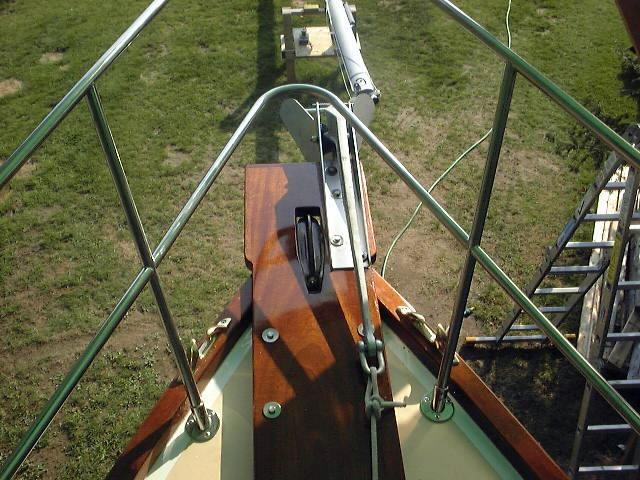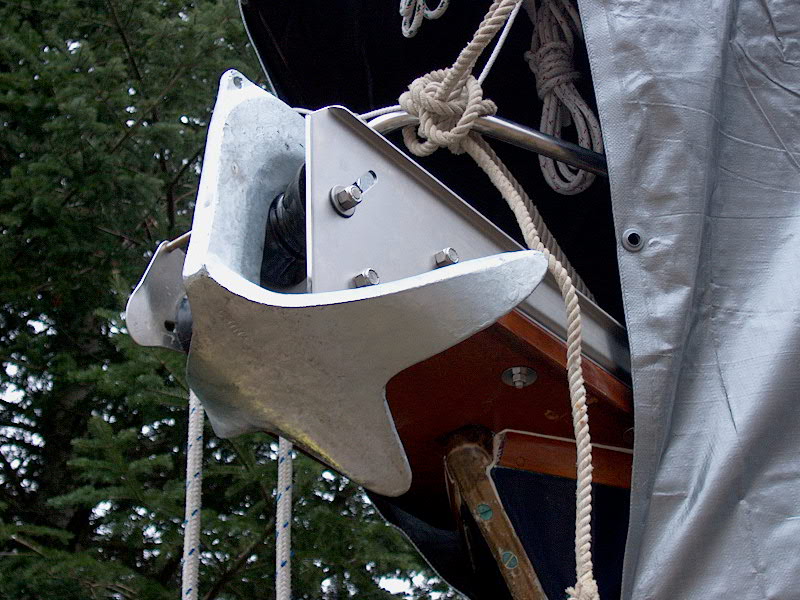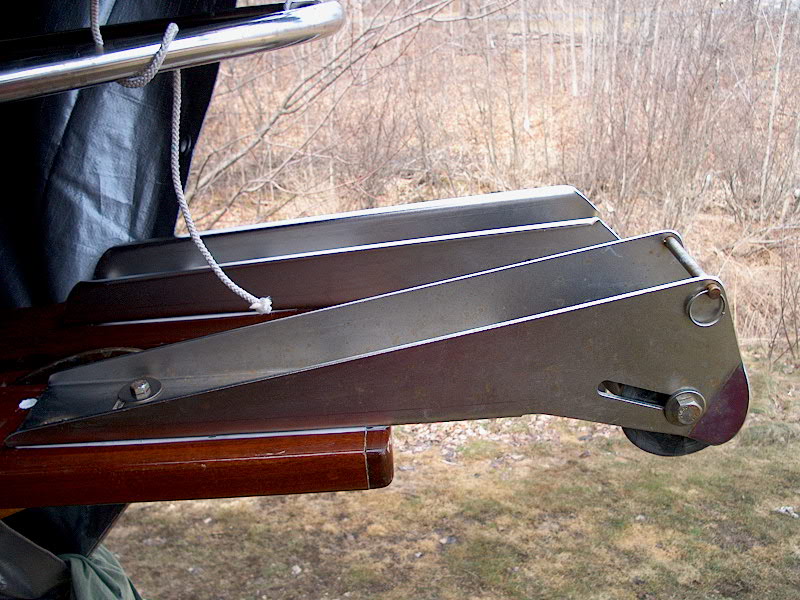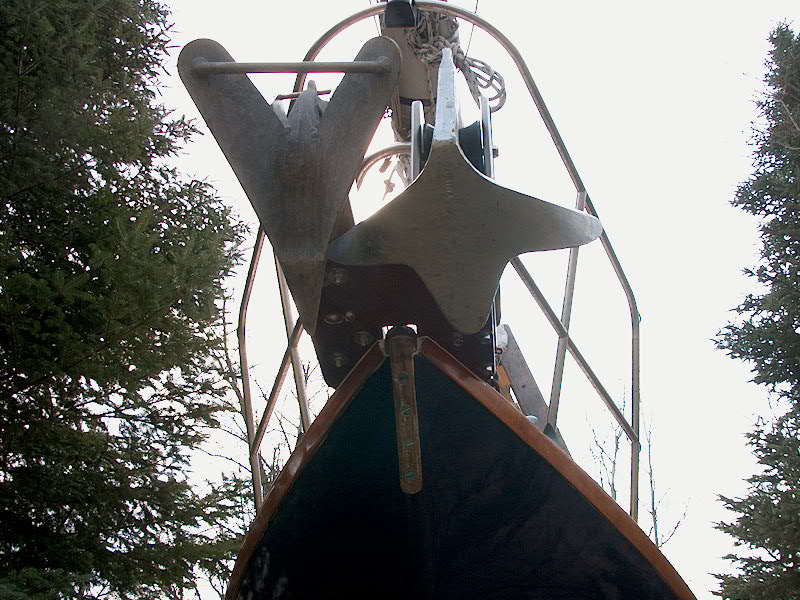|
Anchoring Setup and Ground Tackle (Page 2)
This page was last updated on May 2, 2002
35#
CQR 33# Bruce/Claw
20# Danforth
13#
Danforth
Marking
the Anchor Rodes Anchor Rode
Storage/Chain Pipes
|
|
 35 lb. CQR
Setup (Main Bower Anchor) 35 lb. CQR
Setup (Main Bower Anchor)
 I installed
my Windline URM-1 anchor roller with four stainless steel bolts (in the part overhanging the bow)
and two stainless lags (through the epoxy toerail). Drilling the six
3/8" holes in the stainless steel roller assembly was extremely
fun. I used my big, slow speed 1/2" drill, and kept the holes
lubricated with light oil, which made the cutting much easier. After
the first hole I drilled ended up off its mark--the drill bit had walked and
by the time I noticed it it was too late--I drilled smaller pilot holes
through in each location to give the larger bit something to bite
into. Dumb mistake, but it doesn't really affect anything. I
sealed around each hole in the anchor platform with polysulfide before
installing the bolts, to help seal the raw wood and prevent water from
getting into the wood and varnish beneath. The four forward holes
really didn't need to be sealed, but I thought it would make the wooden
platform last longer and look better. I installed
my Windline URM-1 anchor roller with four stainless steel bolts (in the part overhanging the bow)
and two stainless lags (through the epoxy toerail). Drilling the six
3/8" holes in the stainless steel roller assembly was extremely
fun. I used my big, slow speed 1/2" drill, and kept the holes
lubricated with light oil, which made the cutting much easier. After
the first hole I drilled ended up off its mark--the drill bit had walked and
by the time I noticed it it was too late--I drilled smaller pilot holes
through in each location to give the larger bit something to bite
into. Dumb mistake, but it doesn't really affect anything. I
sealed around each hole in the anchor platform with polysulfide before
installing the bolts, to help seal the raw wood and prevent water from
getting into the wood and varnish beneath. The four forward holes
really didn't need to be sealed, but I thought it would make the wooden
platform last longer and look better.
  With the roller in place, I
could install my 35# CQR for testing, and to assist in placement of the
second roller assembly. It looks pretty cool up there...and woe is the
boat who decided to get into a collision with my bow! The CQR is
attached to a 300', 1/2" nylon rode with 30' of 5/16" hi-test chain. The rode is stored in the chain locker, which I access through
the bronze vent on the foredeck. See below for details. With the roller in place, I
could install my 35# CQR for testing, and to assist in placement of the
second roller assembly. It looks pretty cool up there...and woe is the
boat who decided to get into a collision with my bow! The CQR is
attached to a 300', 1/2" nylon rode with 30' of 5/16" hi-test chain. The rode is stored in the chain locker, which I access through
the bronze vent on the foredeck. See below for details.
|
|
 33 Lb.
Bruce/Claw Setup (Secondary Bower Anchor) 33 Lb.
Bruce/Claw Setup (Secondary Bower Anchor)
Originally, I ordered a 33 lb.
Bruce anchor from Sailnet, but soon found that for some reason anchor is on severe backorder from the
manufacturer. I have found no reasons behind this delay, but all vendors I
have seen do not have this anchor in stock, and some vendors with whom past
experience leads me to trust indicate the same information and potential ship
date.
At first, I thought it would be
OK to wait. As time went on, the expected ship date became later and
later, and eventually I decided that I wanted to have a contingency plan--and
another anchor ready to go. With more unseasonably warm weather and no
sign of any sort of return for winter on the horizon as of mid-March, I figured
I would want to get
moving on some other boat projects--including installing the new anchor roller
on the platform. Well, this cannot be done without the anchor in hand to
make sure it fits, so, seeing a Simpson-Lawrence Claw anchor (33 #) at West
Marine for a reasonable price, I went for it--figuring that I'd rather have the
knockoff now and end the uncertainty over getting one later. So, at least I
have my contingency. I still want the Bruce, and now that I've bought the
Claw it'll probably show up next week. When (if?) the Bruce anchor arrives, I'll
sell the Claw.
|
|
 Anyway,
on a raw spring day in March I decided to test fit my Windline BRM-3 anchor
roller and the new Claw anchor. Armed with the roller and some bar clamps,
I set my ladder up in front of the boat, and clamped the roller in place on the
port side of the anchor platform. Then, I hefted the Claw anchor up there
and placed it in the roller. The anchor is balanced in such a way that it
stays nicely in the roller by itself without a tendency to tip or roll out, so
this sort of testing is easy enough. I immediately noticed an interference
problem with the CQR next door in its own roller: the wide flukes of the
Claw, with both rollers in their respective positions, would prevent the CQR
from being easily raised and lowered. The inner fluke of the Claw
overlapped the CQR by a couple inches. Because the platform is a finite
width, I couldn't move the new anchor roller further outboard to cure the
problem, and I didn't want to angle it out either, as I want a nice, straight
lead off the roller when the anchor is deployed--to ensure that the rode stays
on the roller properly, and that the boat will remain pointing as much into the
wind as possible without annoying (and potentially dangerous) oscillation.
I had been afraid of running into this very problem, but wasn't quite sure how
it would all play out. Obviously, the CQR roller would have to be
repositioned in order to allow the two anchors to coexist. Anyway,
on a raw spring day in March I decided to test fit my Windline BRM-3 anchor
roller and the new Claw anchor. Armed with the roller and some bar clamps,
I set my ladder up in front of the boat, and clamped the roller in place on the
port side of the anchor platform. Then, I hefted the Claw anchor up there
and placed it in the roller. The anchor is balanced in such a way that it
stays nicely in the roller by itself without a tendency to tip or roll out, so
this sort of testing is easy enough. I immediately noticed an interference
problem with the CQR next door in its own roller: the wide flukes of the
Claw, with both rollers in their respective positions, would prevent the CQR
from being easily raised and lowered. The inner fluke of the Claw
overlapped the CQR by a couple inches. Because the platform is a finite
width, I couldn't move the new anchor roller further outboard to cure the
problem, and I didn't want to angle it out either, as I want a nice, straight
lead off the roller when the anchor is deployed--to ensure that the rode stays
on the roller properly, and that the boat will remain pointing as much into the
wind as possible without annoying (and potentially dangerous) oscillation.
I had been afraid of running into this very problem, but wasn't quite sure how
it would all play out. Obviously, the CQR roller would have to be
repositioned in order to allow the two anchors to coexist.
|
|
 Because
the Claw roller assembly pretty much has to be in the position I chose, because
of its design, I decided to go ahead and drill holes for the mounting
bolts. With the roller more securely fastened, I could play with the CQR
and see what I could do. I drilled the holes and temporarily secured the
roller with a couple bolts. This enabled me to move the CQR and see if I
could haul it in and out of its roller and work it around the Claw for
storage. I almost could, but it was impossible to get the pin in the
anchor roller through the eye on the CQR, which is pretty much essential for
secure storage--at least to me. Therefore, I decided to move the CQR
roller so that it extended further out forward of the platform. I had
originally installed it as far back as it could go, but the arrangement is
long enough and strong enough to allow it to be more cantilevered. Moving
it will leave me with two exposed holes in the anchor platform, but I can plug
those. Because
the Claw roller assembly pretty much has to be in the position I chose, because
of its design, I decided to go ahead and drill holes for the mounting
bolts. With the roller more securely fastened, I could play with the CQR
and see what I could do. I drilled the holes and temporarily secured the
roller with a couple bolts. This enabled me to move the CQR and see if I
could haul it in and out of its roller and work it around the Claw for
storage. I almost could, but it was impossible to get the pin in the
anchor roller through the eye on the CQR, which is pretty much essential for
secure storage--at least to me. Therefore, I decided to move the CQR
roller so that it extended further out forward of the platform. I had
originally installed it as far back as it could go, but the arrangement is
long enough and strong enough to allow it to be more cantilevered. Moving
it will leave me with two exposed holes in the anchor platform, but I can plug
those.
|
|
 I
unbolted the CQR roller and moved it forward about three inches--or until the
after set of boltholes lined up with the holes in the anchor platform where the
more forward set had been. I installed a single bolt and temporarily
secured the roller in place so I could check the fit with the CQR and the Claw;
both fit well and will not impede one another when used. A further
advantage of moving the CQR forward is that it should better clear the roller
furling drum now. When I was satisfied with the position of the CQR
roller, I drilled the remaining holes and prepared to bolt both rollers down. I
unbolted the CQR roller and moved it forward about three inches--or until the
after set of boltholes lined up with the holes in the anchor platform where the
more forward set had been. I installed a single bolt and temporarily
secured the roller in place so I could check the fit with the CQR and the Claw;
both fit well and will not impede one another when used. A further
advantage of moving the CQR forward is that it should better clear the roller
furling drum now. When I was satisfied with the position of the CQR
roller, I drilled the remaining holes and prepared to bolt both rollers down.
As before, I sealed around each
bole hole on the platform with some polysulfide, since I figure that this will
help avoid the varnish beneath dying a premature death when water becomes
trapped beneath the rollers. The extra adhesive can never hurt,
either. I secured the CQR roller with four 3/8" bolts, two fewer than
before, although this should be plenty. I secured the Bruce roller with
four 1/2" bolts, since I couldn't use the fifth hole as it was partly over
the toerail. The Claw is attached to 200' of 5/8 nylon rode and 30' of
3/8" BBB galvanized chain.
UPDATE:
Obviously, this reconfiguration was a bad idea. The original platform was
destroyed in a storm in May 2002 while the boat rode on her mooring.
Please click here for more details on the damage
and subsequent repairs.
|
|
 |
 |
 |
|
|
Please
click here to continue. |
|